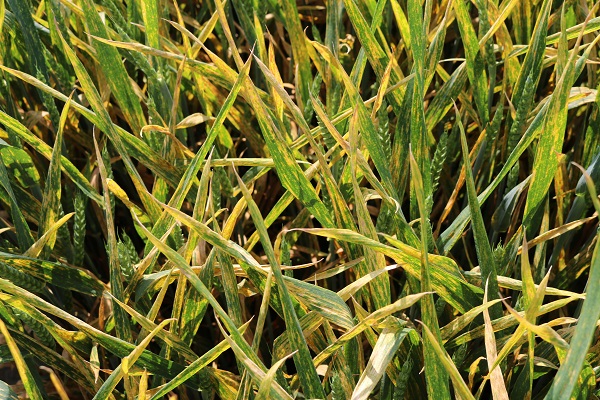
Last season saw the launch of Syngenta’s new SDHI fungicide, Elatus Era. CPM heard from a number of pioneering growers on their experiences of it and how the product fared.
We’re looking to maximise yield rather than cut inputs.
By Rob Jones
There’s a growing band of arable farmers looking for something extra from the primary fungicide purchase. For some, it may be more reliable disease control as pathogens become more challenging, while others look to retain green leaf in an effort to eke more yield per ha.
These were among reasons four progressive growers last year chose to include Syngenta’s new SDHI fungicide Elatus Era (benzovindiflupyr+ prothioconazole) in their programme. They all had different objectives, but all were keen to see what the new product could bring to their fields.

While there are a number of varieties that are pretty good from a septoria point of view, if they needed help, it would probably be against rust.
Persistence provides a plus
Notts arable farmer Tom Hawthorne has a clear vision of what he wants from his main T2 SDHI fungicide in winter wheat. Firstly, outstanding rust control to complement reliable septoria activity. And secondly, persistency, to cope with the vagaries of late-season weather and disease pressure.
Tom’s a partner at Flawborough Farms, a 2200ha family-run business comprising 400ha of owned land with the rest run under various contract farming arrangements. All 800ha of the business’ winter wheat are in Group 1 milling varieties, including Skyfall, KWS Trinity, KWS Zyatt and RGT Illustrious. Quality is strived for, but the business also pushes for yield as much as possible.
“We’ve been using modern SDHIs ever since they’ve been around, especially at T2,” explains Tom. “We see Elatus Era as the beginning of the next generation and chose it because it seemed the best option.”
There were two main reasons for using it, he explains. “Firstly, it gives amazing rust control – of both yellow and brown rust. A lot of the varieties we grow are pretty good from a septoria point of view. But for some of these, if they needed help, it would probably be against rust.

For those who farm sensibly and grow decent varieties Elatus Era has a lot to offer, says Tom Hawthorne.
“But we also chose Elatus Era for its persistency as an SDHI. It does give that long-lasting protection of the leaf and its persistency is excellent. If you farm sensibly and grow decent varieties I can see no reason not to use it,” he adds.
By that, Tom means staying ahead of disease to avoid getting into an eradicant situation. That’s the strategy he follows closely, opting mostly for a four-spray fungicide approach to protect the crop right through the season.
Nevertheless, flexibility is built into the programme. So, while he’s committed to Elatus Era again at T2 in 2018, it’ll depend on the variety and how the season shapes up as to whether an SDHI is included at the earlier T1 timing. Likewise, whether a strobilurin plus triazole or a triazole-only approach is used at T3 on the ear.
“I like to be semi-flexible,” explains Tom. “I spend what I think I’ll need to spend at the time. If that means £140/ha spent on fungicides I’m prepared to do that. But if the season allows me to cut the bill to just £80/ha, then I will. While yield is important, it’s margin that counts, so whatever it’s worth, you should still keep your eyes on cost.
“Persistence at T2 is important because there can be a prolonged time between T2 and T3. Similarly, I always use branded Bravo (chlorothalonil), that has the Weatherstik formulation. It takes a lot of rinsing out of the sprayer induction hopper, which gives a good indication that it sticks to the leaf.
“Septoria tritici is always present to some degree, and all the SDHIs are similar on it. But rust can take yield away very easily. With Elatus Era, the way I look at it is we’re getting the rust control for free.”
That said, it’s not just the new fungicide itself that’s a winner for Tom Hawthorne. He says its S-Pac containers are also part of the product’s appeal.
“They’re excellent for the operator. The packs are clearly marked to show whether they’re fungicides or herbicides, the lids are easily removed, and they pour and rinse well when filling the sprayer. It’s all obvious stuff, but it’s important. I can’t see a reason why I’d move away from Elatus Era,” he confirms.
Keen to keep it green
Looking to improve retention of green leaf area to maximise yield of his wheat crops, Lincs grower, Kevan Johnson of LA Johnson and Son, is suitably impressed with new SDHI fungicide Elatus Era having tried it last year.
Farming between Stamford and Grantham, with 1100ha of his own land as well as managing crops under various contract and share farming agreements, he opts for a simple rotation of mainly winter oilseed rape and winter wheat – the latter a mixture of Group 1 milling wheat Crusoe and Group 4 feed wheat KWS Santiago.
With a focus on yield, he’s a firm believer in investing in modern inputs that’ll deliver a shorter-term return, rather than adding to fixed costs with the latest shiny machinery – reasoning that machinery is reliable enough nowadays to buy second hand and avoid a big hit in depreciation.
Treating all 650ha of his winter wheat with Elatus Era at T2 last season – after seeing its performance at Syngenta’s Newark Innovation Centre in conjunction with Beeswax Dyson Farming the previous season – it’s a strategy that’s paid off.
Last year’s wheat yields beat his five-year average. That was despite the dry spring, which he reckons caused wheat crops to mature a bit earlier, even on the farm’s clay soils.
“Previously, I’d been using another SDHI fungicide because I liked its green leaf area retention characteristics,” explains Kevan. “But I thought the Elatus Era, if anything, looked even better for green leaf retention in the trial plots.
“In terms of disease control, it was also certainly as good as, if not better than, my standard SDHI treatment in the trial. So last year I decided to use it across all my wheat.”
Despite high brown rust pressure late in the season last year, Kevan Johnson says neither his Elatus Era-treated Crusoe nor KWS Santiago were affected by it. The rest of his programme typically comprises triazole plus chlorothalonil at T0, an SDHI at T1, and a triazole with or without a strobilurin on the ear.
“We wouldn’t throw money away, but our view is we’re looking to maximise yield rather than cut inputs. The longer the crop stays green, the more it yields, and an extra half a tonne of grain is worth a lot of money,” he says.
Yield is the main driver
Clawing back the yield potential of his winter wheat crop is what prompted Oxon grower Mark Oldroyd to try Elatus Era. Farm manager of MES Dart and Partners, near Wallingford, he’s experienced a decline in yields since drilling later in response to blackgrass problems over recent seasons.
This went hand in hand with a growing awareness of tougher disease challenges over his 400ha of winter wheat, so half of these received the new SDHI fungicide at T2 last season.
With wheat yielding well at between 9-12 t/ha – depending on its position in the farm’s rotation, which includes a total of 13 different crops – it’s a strategy that he believes has worked.
“We’ve dropped 1.2t/ha off winter wheat yield since delaying drilling from 10 Sept to 10 Oct,” explains Mark. “Because we’re quite low-lying, soils soon go cold and wet in autumn. So we’re trying to tweak the system to get that yield back.”
Typically Mark uses a four-spray fungicide programme to keep crops in a preventative situation, including either an SDHI or strobilurin at T1 followed by an SDHI at T2. Last season he used Elatus Era mainly on JB Diego and Skyfall – on JB Diego mainly for Septoria tritici control and on Skyfall with the aim of boosting the probability of hitting milling specification.
“We have to get good control of septoria, but we also have yellow rust. Elatus Era looked a good combination product to have in the programme. It looks to be one of the more favourable ones in terms of the control you get of both septoria and yellow rust.
“At the end of the day we did very well for yields. They were up on our average. I think if we’d have cheapened the programme we’d have seen a lower yield.
“The other thing was the straw was clean, which is a good indicator of how good the disease control was. We use the straw ourselves because we also have two dairy units on the farm each with 300 cows. I’ll use Elatus Era again in 2018.”
A winning strike on barley
Yorks farmer Nigel Durdy found it was possible to boost winter barley yield by more than an extra third of a tonne per ha by using Elatus Era in his own field comparison last season.
Farming a total of 800ha at Ninevah Farm, near Doncaster, with a main rotation of winter OSR, followed by two years of winter wheat, then winter or spring barley, he has increasingly introduced barley into the rotation over recent years as a way of managing blackgrass.
All his winter barley is down to hybrid varieties, such as Hyvido Bazooka, with around 80-100ha grown each year, utilising its vigorous growth to compete against the weed.
But while it was primarily introduced to help manage blackgrass, he still wants good yields from the crop.
“The hybrid is doing well,” he explains. “We average about 9.26 t/ha from it, and we’ve definitely seen the competitive effect it has against blackgrass.
“Hybrids aren’t like growing conventional winter barley. They’ve a large flag leaf, so that needs protecting with a T2 fungicide. We find we get extra yield from the hybrid by keeping the crop clean during grain-filling, which increases the grain specific weight.”
With yield in mind, Nigel took an interest in new SDHI-based fungicide Elatus Era last season. Although manufacturer Syngenta focused mainly on launching the product into wheat for 2017, Nigel thought its active ingredients also looked interesting in barley.
To test the product, as well as treating whole fields of hybrid barley at T2 and using some in his wheat, he also conducted his own split-field comparison. Treating 2ha blocks in the same field of hybrid barley, he compared Elatus Era plus CTL against his usual T2 SDHI barley fungicide standard. Both followed a standard triazole fungicide of prothioconazole at the earlier T1 timing.
Come harvest, while the farm’s standard T2 SDHI delivered 9.10 t/ha, his figures revealed Elatus Era-based approach boosted that by an extra 0.36, to 9.46 t/ha, when yields were corrected to 15% moisture. Specific weight also showed an improvement, he notes.
“I thought Elatus looked a decent barley product. As well as SDHI, it also contains prothioconazole, which I feel is a key ingredient when it comes to barley. In combination with the SDHI in it, I thought it looked like a winning strike.
“There’s no doubt where Elatus Era was used that it did yield better. It was a cleaner crop. Even the combine driver, my brother, noted it looked cleaner, and was less dusty and easier to harvest, and he didn’t know which plot had received which treatment,” he adds.
“Increasingly with barley, I think we also need to include CTL as part of the fungicide programme. I use it at the T0 timing on winter barley, but I would use it again at T2. The reason is ramularia – agronomists are saying if you don’t use it you’re leaving yourself wide open.
“More people are growing barley – both winter and spring. The way I look at it, the more barley that’s out there, the greater the risk of infection from neighbouring crops.”
Pioneer Pointers: Elatus Era
Whenever something new appears on the market, there are a select few who take the initiative and give it a go. These are the pioneers who manage change and take a step forward, not just for themselves but for the entire industry. The rest of us wait for the informed view to point us in the right direction.
CPM would like to thank the pioneers who have shared their views on Elatus Era in this article, sponsored by Syngenta.
Elatus Era is a major new weapon in the fight against cereal diseases, combining Syngenta’s latest foliar SDHI, benzovindiflupyr (also called Solatenol), with the respected triazole, prothioconazole. As well as powerful disease control, it has also provided consistent yield benefits and complete protection of leaves against disease in wheat, with similarly impressive results in barley, a crop where its launch is being expanded this year.
Find out more at elatus-era.syngenta.co.uk




